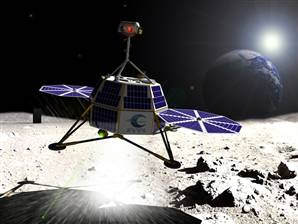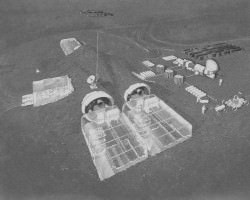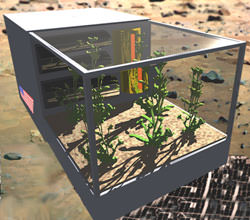[/caption]
“Imagine a bright flower on a green plant in a little dome-shaped growth chamber, sitting on the landscape of the Moon, with the Earth rising up behind,” said Taber MacCallum, CEO of Paragon Space Development Corporation. “I think it’s a great vision.” That vision of the first Moon flower will likely become a reality, perhaps by 2014. Paragon has teamed up with Google Lunar XPRIZE contender Odyssey Moon to deliver a biological greenhouse to the lunar surface. “We’ve grown plants in space before, but this will be the first time we’ll attempt to grow a plant on another world,” MacCallum told Universe Today. “It’s not just a great vision, but interesting science, too.”
Odyssey Moon is one of the teams vying for the $30M Google Lunar X PRIZE, a competition for the first privately funded team to send a robot to the moon, travel 500 meters and transmit video, images and data back to the Earth. One image may be the striking vision the MacCallum described.

Paragon has been involved with biology in space for several years. They developed the payload that bred the first animals through their life cycle on board the Mir space station, and also were part of the early commercial biology experiments on the ISS. The company is now working with NASA to develop the thermal control and life support systems for the new Orion and Altair spacecraft which will bring humans back to the Moon.
But growing a plant on the Moon, well, that’s just plain cool, says MacCallum.
“It’s interesting science in that, while we’ve obviously grown plants in 1 g and done a fair amount of work in microgravity in space, nobody understand the fractional gravity story,” said MacCallum. “Is one-sixth gravity enough for a plant to behave like it’s on Earth, or is that not enough?”He added this project will also provide information on how to create future larger self contained lunar outposts and eventual settlements, which likely will include greenhouses for growing food for colonists.
Growing the first plant on another world has enormous symbolic importance as well. “We’re doing this partly because of the science, but partly because its an interesting time to be inspiring people on things that aren’t necessarily associated with the economy,” MacCallum said.” Especially in tough economic times we need to inspire people to say, ‘Man that’s cool! What a great country we have that we can do this!’ We also need to inspire kids to take math and science. Kids’ eyes light up when we talk about things like this!”

MacCallum and his wife and co-founder of Paragon, Jane Poynter are well known experts in the closed biological systems communities, and were themselves experimental subjects within a sealed ecosystem as resident scientists in the famous Biosphere 2 project of the early 90’s. They spent two years living with six others in a 3.2 acre greenhouse type structure in Oracle, Arizona, the largest closed system ever built.
“Plants have been grown in essentially zero gravity and of course in Earth gravity, but never in fractions of gravity,” said Dr. Volker Kern, Paragon’s Director of NASA Human Spaceflight Programs who conducted plant growth experiments in space on the US Space Shuttle. “Scientifically it will be very interesting to understand the effects of the Moon and one- sixth gravity on plant growth.”
NASA Ames planetary scientist Dr. Chris McKay will also be supporting the project, which is called Lunar Oasis. “The first plant to grow from seed and complete its life cycle on another world will be a significant step in the expansion of life beyond the Earth. The sooner we do it the better,” he said.
MacCallum said there are technical requirements they are still working on for the greenhouse, such as oxygen –CO2 exchange and the right materials that will let in sunlight but block the sun’s harmful rays. “It’s going to be a small growth chamber, but even that is pretty complicated,” he said.
In addition to leading the design of biological payloads, Paragon’s responsibilities on the Odyssey Moon team include robotic lunar lander design support and the lander’s thermal control system.
Source: Paragon, interview with Taber MacCallum
Here’s info on a similar project. Remember Biosphere 2?


by 2014?
Highly doubtful.
A couple of hemp seeds and some vitamins and I’ll grow some grade A stuff wherever you want.
It would be great to see something like this happen.
It would need to be smartly designed or it will fail pretty quickly.
And failures with lots of money because of space research are just not a good thing.
Also, what about hydroponics?
I have no doubt they can design a lander with a growth chamber in just a year or two.
The sun provides plenty of solar energy on the moon and every thing else the plant needs can be cycled in by the spacecraft for the duration of the mission.
It only has to last a month or two (depending on plant) to prove the point and claim the record.
Whats expensive is finding a rocket to take you there.
But when is the life cycle of a plant really completed? I guess it is only after the original seeds led to a new generation of germinable seeds. If the experiment cannot show biological adaptation thru genetic selection to be “fruitful” on the Moon then there is no real success, in my opinion. Otherwise, the experiment could lead to a new branch in the phylogenetic tree of life. Therefore, this experiment should last as long as possible, so that evolution has the time to transform that plant species.
So I also wonder what plant species they will use.
Natural evolution doesn’t work at that kind of pace.
Genetic tinkering and selective breeding can speed up the process, make plants more tolerable to a low resource habitat.
You’ll need to land people on the moon to really make it work tho, and its a project that would take decades at best.
Not to say we cant get a head start on earth. Probably by making a greenhouse to simulate low pressure environments with odd sunlight cycles.
The only thing we cant simulate is low gravity.
“Natural evolution doesn’t work at that kind of pace.”
What are the factors that speed up the time needed for evolutionary change? Shortness of the reproduction cycles and a striking success of a inheritable promotive feature.
Could one hundred cycles with each one require maybe two month not show a significant evolutionary effect already after fifteen years?
It would have been great vision to remember that night lasts for 2 weeks on the moon.
Useless place to grow plants.
Not really, There are places on this planet where the ‘Night’ can be far longer than two weeks. Plants and trees survive well in some of these places provided there is enough water, nutriments andt he temperature is high enough. So what if the ‘Night’ is two weeks long. Anyone going to provide the plant with a Watch?
Easy solution: add a strong light source, and a droid like Huey or Dewey to feed and water it 🙂
I hate the moon! Put it on Mars.
The transport of resources to the moon to grow plants there is cost-intensive. But so is the transport of food also. How could in-situ production become more cost-effective than import from planet earth. The further human spacefight might carry astronauts away from home, the more important would be the factor of transportation costs.
If with such experiments is intented to lay the foundations for self-supply of lunar outposts, then the goal should be to find out how far artificial support of plants can be reduced: adaptation would decrease operating expenses.
We could find out to what degree plants might adapt to lunar conditions. For example, how would plants interact with lunar soil, if exposed to it to a limited degree?
Plants should adapt in an evolutionary process. So such an experiment should keep the plants alive with artificial support while in the same time they are exposed to some specific aspects of the lunar environment.
Or could plants go into some sort of “strategic alliances”, or symbiosis, with microbes which could adapt much faster?
Or remember the research of Arturo Casadevall from the Albert Einstein College of New York. It would be interessting to find out what his “Chernobyl fungi” could contribute in symbiosis with other organisms in a harsh and defective lunar context. Could those fungi provide plants with energy derived from radiation?
I guess we should send a whole fleet of bio kits to the moon to do the basic research.
If you want to accomplish this on a short time scale we’d need to be giving up on evolution and going strait to intelligent design. Scientists will have to decide what the final habitat is going to be and pull out all the stops to make crops that can survive there.
I don’t think we can evolve plants to live directly on the surface with what we know… But if we can make them to survive in easier to build structures (like a barely pressurized trench with a sun shade tossed over it) that goes a long way.
One good candidate I suspect might be some form of green algae. It can grow in tubes with minimal manpower, no soil, and would be a cheap way to refine the atmosphere and water supply of a moon base.
Figure out how to eat it and that would be a great solution for the near future.
If they really wanted and had the resources to, they could send a greenhouse to the Moon in 3 years.
“…on a short time scale we’d need to be giving up on evolution and going strait to intelligent design.”
Way-out! Establishing a Craig Venter Institute on the Moon? Assisting human presence in deep space with the help of genetic engineering? Expermimenting with punctual and limited terraforming in a lunar volcanic tube? Awesome!
This will certainly happen sometime in the future and we are getting closer to this reality day by day.
“sitting on the landscape of the Moon, with the Earth rising up behind,” said Taber MacCallum, CEO of Paragon Space Development Corporation.”
Mr. MacCallum, The Earth does not “rise up” if your sitting on the landscape of the Moon. It is gravitationally locked with Earth. Please do your research before you try and pull this off with the astronomical community. Thank You
I dont get the point of this….
I am not sure, Tim, but maybe the meaning of “to rise up” is different from “to rise”. Are you an English native speaker? Because I would rather say that that sentence is equivalent to “sitting on the landscape of the Moon, with the Earth towering above”. I would guess, that you wrong Mr. MacCallum.
The phenomenal pictures taken by Apollo 8 called “earthrise” were a result of the astronauts spaceship coming around the moon.
It reinforced the popular notion that the earth rises and sets like the sun… which it doesn’t. But I think its a forgivable mistake.
If you asked me a week ago I’d have probably thought the same (never really considered it before).
Still, its a powerful notion to see earth as just another planet. Sitting nonchalantly in the distance over a desolate landscape, with a lone flower growing in the foreground.
I look forward to seeing it.
Maxwell,
“Rising up” describes a static situation, thus the Earth need not “rise”, because “to rise up” describes the object on a fixed position. It just expresses that the object is above another one. That it just towers above another object in someones perspective.
I’m no English native speaker, so correct me if I’m wrong. Otherwise I do not think that Mr. MacCallum made any “forgivable mistake” here, because he made no mistake at all.
Nothing is wrong with saying “sitting on the landscape of the Moon, with the Earth rising up behind”, because a “rising” Earth is not presumed when Earth is “rising up”. Am I right or wrong? 🙂
That CEO guy is remarkably stupid. “with the Earth rising up behind”. COME ON! The Earth does not move in the Moon’s sky!